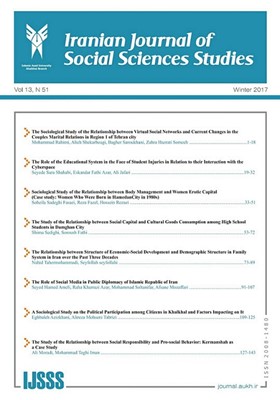A Comparative Study of the Power Structure in the Family and its Relationship with the level of Social Participation Case study: Kerman (urban and rural) 1396
Subject Areas : FamilyFateme Soltanpoor 1 , Hossahn AGHAJANI 2 , Alireza Kaldi 3
1 - PhD student in sociology, Islamic Azad University, Central Tehran Branch
2 - Associate Professor of Islamic Azad University, Central Tehran Branch
3 - Profeassor of Sociology of Science and Research Branch, Islamic Azad University, Tehran
Keywords: social participation, power structure, participate in social activities,
Abstract :
The aim of this research is paying attention to the power structure in the family and its influential role on social participation in the city and villages of Kerman in 1396. This research has been done by survey method. According to Sharp Cochran formula, the city sample size is 384 families and the sample size in villages is 118 families. Cluster sampling and random sampling were used as sampling methods and the questionnaire technique was used. Validity of the questionnaire was validated by five university professors who were native and for reliability the spss was used; reliability was 0.98, it means the research is valid and applicable.Base on the independent T-Test significant difference can be seen between the power structure of the family in the city and the village. In the urban community, structure of the family is relatively symmetric, and in rural community the power construction was unilateral and father-centered which has affected social participation. According to research results, such as what Durkheim emphasizes on increasing coherence in the transition from the mechanical community to the organic community. In the above society, when moving from the rural community to the urban community, we see more symmetrical power and a high level of social participation.
_||_


